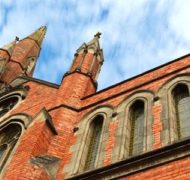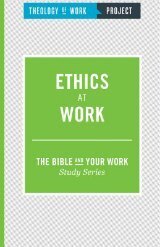Advent Church: A Ritual for Today
Blog / Produced by The High Calling
For many Christians, we experience the same rhythm in our worship services each week we go to church.
Kevin DeYoung lists the typical program: (1) Casual welcome and announcements, (2) Stand up for 4-5 songs, (3) During the set, or at the very end, add a short prayer, (4) Sermon, (5) Closing song, and (6) Dismissal.
Perhaps we might add to this when we take the offering with special music, and on the weeks we do communion or baptism we might mix it up a little.
Some people are starting to yearn for more … dare I say it, liturgy and ritual. Many Protestant churches moved away from a liturgical gathering—what has been called “high church” where the worship service embraces the rituals of sacraments, confessions, Scripture readings, and preaching—and created the “low church,” which is much more focused on just the sermon and worship music.
Make no mistake: what DeYoung lists is in fact a liturgy, and he says so. But, he says, “not every liturgy is as good, or strong, or deep, or biblical, or gospel-centered as every other.” Advent is a part of the ancient church’s liturgical calendar.
Advent may seem novel to many Christians in the United States, but this ritual dates back to the last part of the 6th Century. “Advent” (Latin Adventus) means “coming,” a time to contemplate the first coming of Jesus Christ in anticipation for His second coming. It is an ancient ritual that has started to become common practice in many American churches today. Practicing rituals like Advent creates a church culture.
Creating a Church Culture that Embraces Ritual
If James K. A. Smith is right in his book Desiring the Kingdom, we are molded by our liturgies. Smith recently told Christianity Today, “We are ritual, liturgical creatures whose loves are shaped and aimed by the fundamentally forming practices that we are immersed in.”
Winn Collier affirms this. Even though our church rituals seem at times monotonous and plain, and even though “sometimes the whole shebang seems limp and cold,” he writes, “I’ve come to believe that our feelings in this immediate moment matter far less than we might think … The work God does often winds a long and tedious way. The rhythms, the tedious spiritual practices, will—over the many years and if we plod along in faith—form us into people who know God and love God.”
Micha Boyett embraces yearly rituals as well. On December 6th each year, her family celebrates “St. Nicholas Day.” “I long for my children to have meaningful rituals in their lives. I long for them to know that Christmas gift-giving is not simply about their own wants and desires and that Santa Claus is not just a jolly man with every toy in the world at his disposal. I want them to believe that Santa is St. Nicholas, a man who loved Christ, who gave sacrificially, who celebrated the gift of Jesus … It is Advent, and we are invited into a bigger story than the parties and the travels and lists of gifts still left to purchase.”
Whether we want to believe it or not, we are a people who cherish Rituals, Rhythms and Routines. And Advent is one of those—something we do each year where we are asked to wait for God. Brad Briscoe wrote, “Advent holds a lesson for all of us in this busy world, especially organizational leaders. What would it look like to wait, to incarnate the lesson of Advent in one’s daily work life?”
Winn Collier affirms this:
“Our culture prods us to sprint toward Christmas, but Advent insists we wait. Advent says Not yet. Hold back. Advent asks this of us every single year. Whether we are spiritually invigorated or experience only lackluster faith, Advent pulls us all into the same room every Sunday and says, Hold on. You need to sit a while. And sit a while with others. You need to pay attention. You need to watch for God and put your hope in God.”
See Winn Collier’s article here: Advent Church: Rhythms Make Us Wait for God
See Micha Boyett’s article here: Advent Church: Celebrating St. Nicholas
Creating a Church Culture that Focuses on Jesus
Scot McKnight explains that “Advent is the day God pitched his tent to be with Israel. It is the day God became one of us. An Advent church knows Jesus is God with us.”
According to McKnight, “Advent is the beginning of the church year, and it is also the beginning of creating a church culture.” He provides very practical ideas of what an “Advent Church Culture” looks like, all centered on the fact that Advent proclaims that Jesus is God with us. An Advent Church knows who Jesus is, strives for a Jesus-shaped mission, practices Jesus-shaped spiritual disciplines, and tells the Jesus story all year long. He says, “Some church cultures are blazingly brilliant and so drenched with grace that people can’t wait for Sunday when the people all gather for worship and Word and sacrament.”
See Scot McKnight’s article here: Advent Church: God with Us in Jesus
Creating a Church Culture that Empowers the Laity
Skye Jethani says that if we overcome our belief in a sacred/secular divide, pastors will be able to abandon the pressure to grow and manage very large ministries (VLMs) and instead focus on their call to word and sacrament. The sacred/secular divide is a view which “holds that the world is split into that which God cares about (sacred) and that which is ultimately unimportant (secular).”
“Accounting, from this perspective, is secular work without any eternal value, but doing accounting for a church—well, now you’re counting beans for the kingdom of God. Rather than affirming the work of Christians serving as counselors, mechanics, or fitness trainers out in the community, ministries incorporate these activities in order to give them validation. Over time this desire to sanctify our work results in VLMs housing restaurants, auto repair shops, fitness centers, retail stores, clinics, and a plethora of programs for volunteers to staff.”
So an Advent Church creates a culture that jettisons the sacred/secular divide and affirms that all work outside the church is sacred.
See Skye Jethani’s article here: Advent Church: Is the Era of Mega-Ministries Ending?
We hope that this series has been edifying for you. If there is an article that may help a friend, family member, or somebody at church, perhaps you might consider forwarding it to them.
______________________
Advent Church
It’s not a secret: sometimes it’s hard to find Jesus in church. Some of us have gotten used to the routine and the way things unfold in our weekly church services, and we just can’t seem to move beyond going through the motions. Others of us have been disappointed or we’ve become disenchanted, and we’ve decided to look for Jesus outside the church building. Others have gotten bored with the whole thing, and no longer expect to find Jesus in either the church or the Church. And then, there are those of us who find great comfort and deep meaning in both the church building and the Church of God.
Jesus built the church on Peter’s confession that Jesus is the Christ, the Son of Living God. Jesus pronounced that not even the gates of hell would prevail against it. Christ’s grace is at work in the church. And in the Church. In Advent Church, let’s celebrate the truth that Jesus is the Christ, the Son of the Living God, and let the Church say, “Amen.”
Image by Tim Miller. Used with Permission. Source via Flickr.





